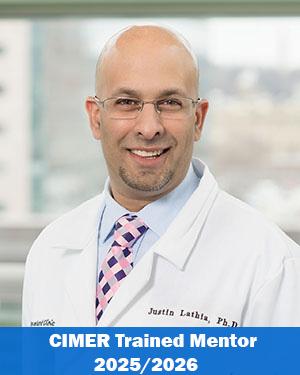Research News
01/21/2020
From Bench to Bedside: Low-Dose Chemotherapy Reduces Myeloid-Derived Suppressor Cells in Glioblastoma
In a great story of research translation at Cleveland Clinic, basic research findings from Dr. Lathia’s lab—which elucidated the mechanistic role elevated levels of a certain type of immune cell plays in glioblastoma development—have reached early-stage clinical trial.

According to a new bench-to-bedside clinical investigation recently published in JCI Insight, a combination therapy featuring low-dose capecitabine plus bevacizumab was well tolerated by patients with glioblastoma (GBM) and was associated with a reduction in circulating myeloid-derived suppressor cell (MDSC) levels and rise in cytotoxic immune infiltration into the tumor microenvironment.
Despite aggressive treatment approaches, the median survival for patients with GBM is 14 to 18 months. The standard of care currently involves maximal safe surgical resection followed by concomitant radiation and chemotherapy with temozolomide, but this approach is often unsuccessful and leads to recurrent tumors and few options for patients.
“Similar challenges in other cancer types have been overcome with immune-modulating therapies, and this has sparked interest in modifying the immune system in GBM,” says the study’s lead author, David Peereboom, MD, a medical oncologist in Cleveland Clinic’s Rose Ella Burkhardt Brain Tumor and Neuro-Oncology Center. “While a number of immunomodulatory approaches are being evaluated, the immunosuppressive nature of the disease remains an obstacle.”
The study was prompted by mounting evidence—including from the lab of Justin Lathia, PhD, Associate Staff, Department of Cardiovascular & Metabolic Sciences, and a co-author on the study—that elevated levels of circulating MDSCs contribute to GBM. “Preclinical models suggested that low-dose chemotherapy reduces MDSCs,” notes Dr. Lathia, “but the use of this strategy in patients with GBM required further study.”
Study at a glance
To explore this approach, the researchers initiated a phase 0/1 dose-escalation study to evaluate capecitabine’s ability to reduce circulating and tumoral MDSCs and to assess its tolerability alone and in combination with bevacizumab in patients with GBM. This work built on the team’s previous evaluation of this approach in a preclinical model.
Here, the study involved 11 patients with recurrent GBM treated with low-dose capecitabine 5 to 7 days prior to surgery, followed by low-dose capecitabine and bevacizumab after surgery. Patients were enrolled in one of three escalating capecitabine dose cohorts, each given twice daily: 150 mg, 300 mg or 450 mg.
All three doses of capecitabine were reported to be well tolerated in combination with bevacizumab, with no serious adverse events related to the combination of the two drugs. Reported grade 3 adverse events were thromboembolism, dyspnea and anemia. Grade 1 and 2 events included fatigue, hypertension, nausea and vomiting and a small intracranial hemorrhage (observed in one patient).
Peripheral blood MDSC concentrations were evaluated before treatment, during surgical resection and after resection. Results showed that MDSC levels were higher after surgery relative to baseline in the 150-mg treatment group, but were reduced from baseline in the 300-mg and 450-mg groups. In the 300-mg and 450-mg groups, increased cytotoxic immune infiltration was noted following capecitabine treatment compared with untreated GBM patients in a reference cohort.
Conclusions and next steps
These findings support the potential of low-dose capecitabine—given preoperatively, and then postoperatively with bevacizumab—for recurrent GBM, the researchers concluded. They noted that the therapy had an acceptable safety profile and that preliminary results indicated progression-free and overall survival rates comparable to those in historical controls.
Notably, tumor immune profiles were analyzed in this study using surgical samples gathered before bevacizumab treatment, excluding the possibility that bevacizumab contributed to the intratumoral effects observed. Additionally, although circulating MDSC levels were assessed while patients received combination therapy, the MDSC changes were observed before bevacizumab administration began. “The decreasing MDSC levels also occurred in a capecitabine dose-dependent manner, making it unlikely that bevacizumab played a significant role,” the authors wrote.
“Based on comparisons of the immune populations among the capecitabine-treated groups, we determined that the middle dose (300 mg) delivered twice daily is optimal, leading to the most significant reduction in circulating MDSCs without impacting lymphoid populations required for an antitumor immune response,” says Dr. Lathia, who is also co-director of Cleveland Clinic’s Center of Excellence in Brain Tumor Research and Therapeutic Development.
“Additionally, we observed that 5 to 7 days of priming the immune system with 300 or 450 mg of capecitabine twice daily enhanced the antitumor immune cell populations within the tumor, including CD8+ effector memory cells and natural killer cells,” he adds. He notes that while these results lack the statistical power to elucidate capecitabine’s complete effects on patients’ tumor immune responses, they support larger trials using the 300 mg dose twice daily.
“Based on these findings, successful immunotherapy strategies for GBM will likely require an approach that involves targeting the immune suppressive effects of MDSCs as well as immune activation tactics to overcome GBM-induced immunosuppression,” Dr. Peereboom concludes.
Story adapted from Consult QD.
Featured Experts
News Category
Related News
Research areas
Want To Support Ground-Breaking Research at Cleveland Clinic?
Discover how you can help Cleveland Clinic save lives and continue to lead the transformation of healthcare.
Give to Cleveland Clinic